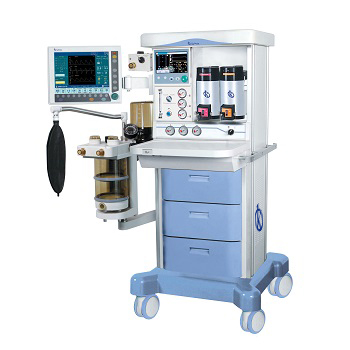Anesthesia machines are medical equipment that guarantee the supply of an exact amount of anesthetic gas to a patient during a surgical process, with the aim that their health is not compromised. They provide safe, adequate, programmed and continuous or intermittent administration of oxygen, medical gases and anesthetic agents; allowing spontaneous or controlled ventilation of the patient.
Composition and operation of anesthesia machines
These equipments are products of mechanical, engineering and electronic innovation, since they are the result of a mixture of electrical, mechanical and pneumatic components, and integrate all the components necessary to carry out general anesthesia. They are composed of vaporizers, fans, breathing system, monitors and sweep systems.
Anesthesia machines receive medicinal gases and accurately distribute the flow and pressure of each gas according to the needs of the patient, these settings are usually inserted manually by the operator. These must be handled by highly qualified medical personnel trained in their use, who must also periodically verify their calibrations and operation.
These teams have monitoring systems and analyzers. Also alarms and physiological record that allow proper control of anesthesia doses. On the other hand, it is capable of monitoring changes in vital signs, regardless of whether they are the result of surgery or anesthesia.
Importance of the anesthesia machine
Anesthesia machines are very important high-precision equipment in the surgical process, because they provide appropriate and safe conditions for the work of surgeons. Anesthesia machines have become extremely essential equipment in hospitals and have been developing throughout history, to the point that modern anesthesia machines allow to control a series of vital functions and even calculate dose ranges in particular.
These equipments are conceived as medical instruments capable of administering anesthetic gases taking advantage of the pulmonary absorption of these gases. Among its functions we can mention:
- Administer anesthesia.
- Control its depth.
- Completely manage the patient’s breathing.
- Monitor respiratory variables.
- Monitor their own performance.
Types of anesthesia machines
- Continuous flow: They are the most used. They are designed to provide a precise supply of medical gases (oxygen, nitrous oxide and air) mixed with a precise concentration of anesthetic vapor, continuously delivering this mixture of gases to the patient safely. They can be used to administer general anesthesia to patients while undergoing medical procedures in operating rooms, delivery rooms, diagnostic or outpatient surgery centers.
- Intermittent flow: These anesthesia machines provide a flow of gas on demand when they are activated by the patient’s own inspiration.
At Kalstein we are MANUFACTURERS of medical equipment of the highest quality and that are designed with the best technology, and we offer you a new anesthesia machine, at the best PRICES on the market. That’s why we invite you to take a look at the Products menu. HERE


